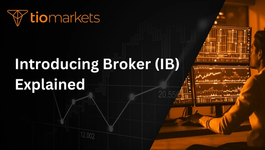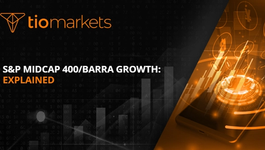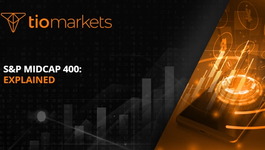S&P 500 VIX index: Explained
BY TIOmarkets
|August 15, 2024The S&P 500 VIX index, also known as the Volatility Index, is a crucial tool for traders and investors worldwide. It provides a measure of market risk and investor sentiment, acting as a barometer for the expected volatility in the S&P 500 index over the next 30 days. This article will delve into the intricacies of the VIX, explaining its significance, calculation, and how it can be used in trading.
Understanding the VIX can be a game-changer for traders. It can help predict market trends, manage risk, and identify potential opportunities. However, the VIX is a complex tool that requires a thorough understanding to be used effectively. This article aims to demystify the VIX, providing a comprehensive guide for traders and investors.
Understanding the VIX
The VIX is often referred to as the 'fear gauge' or 'fear index' because it tends to rise when investors are nervous and expect significant market fluctuations. Conversely, when the market is calm and investors are confident, the VIX tends to fall. Therefore, the VIX can provide valuable insights into market sentiment and potential shifts in market direction.
However, it's important to note that the VIX is not a direct measure of stock market performance. Instead, it measures the market's expectation of future volatility based on options prices. Therefore, a high VIX doesn't necessarily mean the market will fall, and a low VIX doesn't necessarily mean the market will rise. Instead, it indicates the level of uncertainty or risk in the market.
Calculating the VIX
The VIX is calculated using the prices of a wide range of S&P 500 index options. These options are financial derivatives that give buyers the right, but not the obligation, to buy or sell the S&P 500 at a specified price on or before a certain date. The prices of these options reflect the market's expectation of future volatility, which is used to calculate the VIX.
The calculation involves a complex formula that takes into account the prices of both call options (which give the right to buy) and put options (which give the right to sell), and the time until the options expire. The resulting number is an annualized percentage that represents the expected 30-day volatility of the S&P 500.
Interpreting the VIX
The VIX is expressed as a percentage, with a higher number indicating greater expected volatility. For example, a VIX of 20 suggests that the market expects the S&P 500 to move up or down by about 20% over the next 30 days. However, it's important to remember that the VIX is a measure of expected volatility, not actual volatility. Therefore, the actual market movements may be different from what the VIX suggests.
Generally, a VIX below 20 is considered low, indicating a relatively calm market with low volatility. A VIX above 30 is considered high, suggesting a volatile market with large price swings. However, these are just general guidelines, and the interpretation of the VIX can vary depending on the market context and individual trading strategies.
Using the VIX in Trading
The VIX can be a powerful tool for traders, providing insights into market sentiment and potential shifts in market direction. However, using the VIX effectively requires a thorough understanding of its characteristics and limitations.
One common use of the VIX is as a contrarian indicator. When the VIX is high, it suggests that investors are fearful and expect high volatility, which could signal a market bottom and a potential buying opportunity. Conversely, when the VIX is low, it suggests that investors are complacent and expect low volatility, which could signal a market top and a potential selling opportunity.
Trading VIX Derivatives
While it's not possible to trade the VIX directly, there are several financial products that allow traders to gain exposure to the VIX. These include VIX futures, VIX options, and Exchange Traded Products (ETPs) that track the VIX.
VIX futures are contracts that allow traders to speculate on the future value of the VIX. VIX options are similar, but they give traders the right, but not the obligation, to buy or sell VIX futures at a specified price. ETPs that track the VIX, such as VIX ETFs and ETNs, provide a more accessible way for retail traders to gain exposure to the VIX.
Limitations of the VIX
While the VIX can provide valuable insights, it's important to be aware of its limitations. The VIX is a measure of expected volatility, not actual volatility, so it doesn't provide a direct measure of market risk. Moreover, the VIX is based on options prices, which can be influenced by factors other than market sentiment, such as changes in interest rates or liquidity conditions.
Furthermore, while the VIX tends to rise during market downturns, it's not a perfect predictor of market crashes. There have been instances where the VIX has spiked without a corresponding market crash, and vice versa. Therefore, while the VIX can be a useful tool for traders, it should be used in conjunction with other indicators and analysis techniques.
Conclusion
The S&P 500 VIX index is a powerful tool that can provide valuable insights into market sentiment and potential shifts in market direction. However, using the VIX effectively requires a thorough understanding of its characteristics, calculation, and limitations.
Whether you're a seasoned trader or just starting out, understanding the VIX can help you navigate the markets more effectively. By providing a measure of expected volatility, the VIX can help you manage risk, identify potential opportunities, and make more informed trading decisions.
Start Trading with Confidence at TIOmarkets
Ready to put your understanding of the S&P 500 VIX index into action? Join TIOmarkets, the top-rated forex broker that empowers you to trade over 300 instruments across 5 markets, including Forex, indices, stocks, commodities, and futures. With low fees and a platform trusted by over 170,000 traders in more than 170 countries, you're in good company. Enhance your trading skills with our comprehensive suite of educational resources and step-by-step guides. Create a Trading Account today and navigate the markets with confidence.

Risk disclaimer: CFDs are complex instruments and come with a high risk of losing money rapidly due to leverage. You should consider whether you understand how CFDs work and whether you can afford to take the high risk of losing your money. Never deposit more than you are prepared to lose. Professional client’s losses can exceed their deposit. Please see our risk warning policy and seek independent professional advice if you do not fully understand. This information is not directed or intended for distribution to or use by residents of certain countries/jurisdictions including, but not limited to, USA & OFAC. The Company holds the right to alter the aforementioned list of countries at its own discretion.
Join us on social media

Behind every blog post lies the combined experience of the people working at TIOmarkets. We are a team of dedicated industry professionals and financial markets enthusiasts committed to providing you with trading education and financial markets commentary. Our goal is to help empower you with the knowledge you need to trade in the markets effectively.





